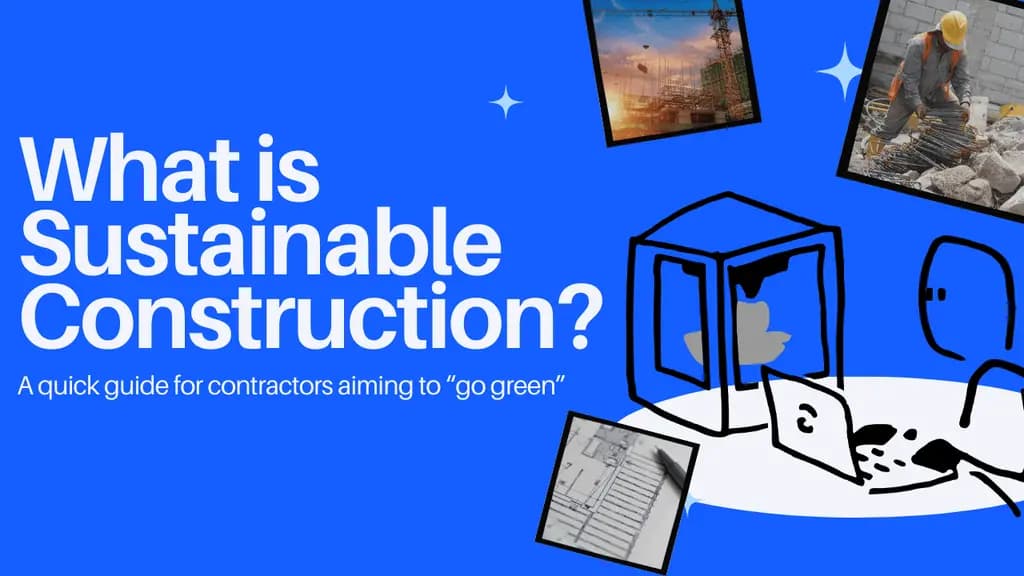Building Green: A Guide to Sustainable Construction
Sustainability in businesses has been a hot topic for the past decade. Businesses and corporations have been seeking ways to operating at a more "environmentally responsible" fashion. As one of the most resource consuming industries, how should contractors working in the construction industry address this demand for sustainability?
by Sheldon Huang
|
What Does “Sustainable Construction” Mean?
Sustainable construction is to minimize consumption of energy and impact on the environment. This is to ensure construction projects are operating while being “environmentally responsible.” Other than projects, construction firms should also make sustainable developments in offices and work places other than sites.
Why Sustainable Construction?
The construction industry is one of the most energy and resource-consuming industries. As corporations are placing more emphasis on sustainability, construction business owners should make project more "environmentally friendly." The goal is to value consequences and take responsibility for using natural resources.
Corporate interest-wise, sustainable buildings and construction brings many benefits to the table, too. One of the fastest ways to reach sustainability is through optimizing workflow and minimizing reworks and maintenance. One of the many by-products is saving construction firms resources.

The next section of statistics demonstrates how much impact the construction industry has made on the environment.
- Buildings and the construction industry are responsible for:
- “Black carbon emissions from open burning of waste are equivalent to 2 - 10 % of global CO2 equivalent emissions.”
- “The world generates 2.01 billion tons of municipal solid waste annually”
- "High-income countries generate about 34 percent…of the world’s waste” as only 16 percent of the world population.
- Construction crews demolish “44,000 buildings and 270,000 homes in the US annually.”
- “Demolition accounts for more that 90% of construction and demolition (C&D) waste in the US.”
- “Up to 15% of materials delivered to build sites are not used.”
- “Globally, about 37% of waste is disposed of in some type of landfill”
- “It is estimated that about 544 million tons of C&D debris were generated in the United States in 2018," which is more than twice the amount of generated municipal solid waste.
- “Construction waste accounts for about 40% of the total solid waste generated worldwide.”
- “Construction activities generate approximately 1.3 billion tons of waste annually globally.”
How to Reach Sustainable Construction?
For construction firms, there are more than a few ways to increase construction sustainability.
1. Utilizing sustainable means of transportation
Greenhouse gases (GHG) are common factors to accelerating global warming. According to the US Environmental Protection Agency (EPA), “transportation” is the largest source of US GHG emission in 2022. The use of gas powered vehicles already poses an issue because of its greenhouse gas emission under daily use. The use of gas powered vehicles under construction settings creates more harm towards the environment.
When transporting material and manpower, construction firms can take advantage of electric or hybrid vehicles. Electric and hybrid vehicles, being efficient while producing little carbon footprint, are optimal options for construction firms going green.
Taking the most efficient routes or reducing unnecessary detours make transportation more energy efficient. This may be more difficult for firms as it takes elaborate route planning and streamlining. Changing means of transportation often requires suppliers to also make changes. Firms can't make changes easily if they receive materials from supply chains using gas-powered vehicles.
With that said, sustainability in transportation should be a priority as reduced emission makes drastic difference.
2. Going digital when managing workflow
One of the most unnecessarily resource-demanding parts of a construction project is the printed documents. Construction companies “manage an average of 5,000 pages every month,” and about half are “never even looked at.” The papers' costs alone cause companies to “spend as much as $27,000 per year to print.” On top of the waste of papers, the use of ink and printers are also extremely energy-consuming.
By transitioning to cloud-based construction management software, the costs associated with physical copies of documents are obsolete. Not only are companies saving more, it is easier to put more effort towards making the industry more sustainable.

3. Help recycle and use recycled
One other aspect that construction teams often overlook is the recycling and use of recycled building materials.
Demolition projects are just as common as construction projects in the industry. After demolition, the construction firm needs to deal with a considerable amount of broken down materials. Traditionally, the materials go straight to landfill. To achieve waste reduction for sustainability, putting the materials through a recycling program has gained popularity in modern years.
Common materials like glass, concrete, and steel can all go through the recycle process and become more sustainable materials. Suppliers often offer recycled materials at a lower price, meaning construction teams can allocate budget to other purposes. Using recycled materials also reduces landfill, saving energy and minimizing the impact landfill has on the environment. Contractors can look to adopt circular economy for recycling materials.

Conclusion
The awareness on sustainability revolves around using resources conservatively and responsibly. This relatively new concept is, without a doubt, a challenge for business owners in any industry.
While sustainable construction comes with numerous restrictions, many of them help contractors save budget as well. Nonetheless, maintaining sustainability while working is a challenging, yet necessary subject of matter that all contractors need to face.
To implement sustainable practices effectively, explore digital tools like Gantt charts and task management software in our article Gantt Chart, Kanban Board & Project Task Management.
Green construction practices often overlap with HVAC innovations. Learn how AI is driving sustainability in AI and HVAC: Driving Efficiencies and Innovation.
